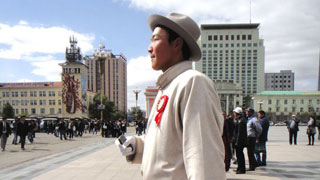Real sector developments
- The economy grew at a furious pace in the third quarter with data showing GDP growth of 20.8 percent year-on-year (yoy), following an equally remarkable outturn of 17.3 percent in Q2.
- There are growing fears of another construction bubble fuelled by the inflow of money into the economy from currently high mineral prices, similar to the previous boom in 2004-08.
Labor Markets and Poverty
- Labor force surveys (LFS) show that unemployment has been gradually trending down, although the overall level is still high at around 9 percent.
- Real wages in informal markets are decreasing as inflation picks up. The October survey results from selected informal labor markets indicate that on average real wages fell since the July survey, as rising inflation is eroding purchasing power.
Inflation
- With food prices and government spending increasing, inflation could rise further.
- September data show headline inflation accelerating to 11.9 percent yoy in Ulaanbaatar, up from 9.9 percent the previous month.
- Rising food prices hit the urban poor (roughly 22 percent of the UB population) extremely hard, as the poor spend most of their income on food, mostly meat.
Fiscal developments
- 2011 budget outturns are in good shape, supported by mineral sector revenues and a booming economy.
- But spending is at record levels, spurred by rising expenditures on cash handouts.
- The 2011 budget amendment aims to increase expenditures beyond the already substantial increase envisaged in the original 2011 budget.
- But the budget amendment is inconsistent with the Medium-Term Budget Framework.
- The 2012 Budget proposes raising spending (mostly on wages and transfers) by 74 percent over the original 2011 Budget. It ramps up spending on large public works projects but under-prioritizes the maintenance of existing public infrastructure
- Mongolia’s universal cash transfers will be replaced by a system of proxy means tested benefits targeted to the poorest households.
External sector
- The trade deficit has widened to record levels as mining related equipment imports have surged.
- The Mongolian Togrog (MNT) has depreciated somewhat against the US$ since mid-August. This was in line with other currencies in the region due to a rising global risk aversion. The depreciation has been relatively small, as FDI (foreign direct investment) inflows into the economy to develop the Oyu Tolgoi mine remain strong.
- International reserves of the Bank of Mongolia declined by about 2 percent from an all time high of US$ 2,460 mn in August, to US$ 2,407 mn.
Banking sector
- MNT and US dollar deposits reached new peaks and credit grew at a record pace.
- Banks are in a stronger position compared to 2008-09 with regard to capital buffers. That said the central bank needs to remain vigilant with regard to financial sector stability on a number of counts.
- Meanwhile the loan-to-deposit ratio (excluding government deposits) has been steadily increasing since the start of the year, and at close to a 100 percent, indicates one source of potentially growing liquidity risks.
- With credit growing as fast as we have seen prior to the last crisis, it is critical that the Bank of Mongolia enforces full compliance of Mongolian banks with current prudential norms, particularly with respect to having adequate capital buffers to absorb the losses from current and possible future NPLs (non-performing loans).
Economic outlook
- The economic rebound in recent quarters has been stronger than expected and the economy is showing signs of overheating. The economy is already running at capacity, driven by the booming mining sector. Although medium term prospects are bright, in the near term the country remains at risk of repeating the boom-bust cycle of the past decade.
- Public sector spending remains strongly pro-cyclical, supported by rising mineral and non-mineral revenues and the government is choosing to mostly spend rather than save windfall receipts.
- The global economic climate remains extremely uncertain as the sovereign and banking sector debt crisis in the euro-zone drags on. These increased global risks make Mongolia enter a phase reminiscent of 2008. The current budget proposals set Mongolia up for a replay of the 2006-8 boom years, leaving it vulnerable to a bust similar to the one that occurred in 2008-9.
- Accordingly, pro-active, prudent and risk-averse economic management is now needed more than ever, as the economy shows signs of overheating while global risks are rising, and mineral prices are falling.

